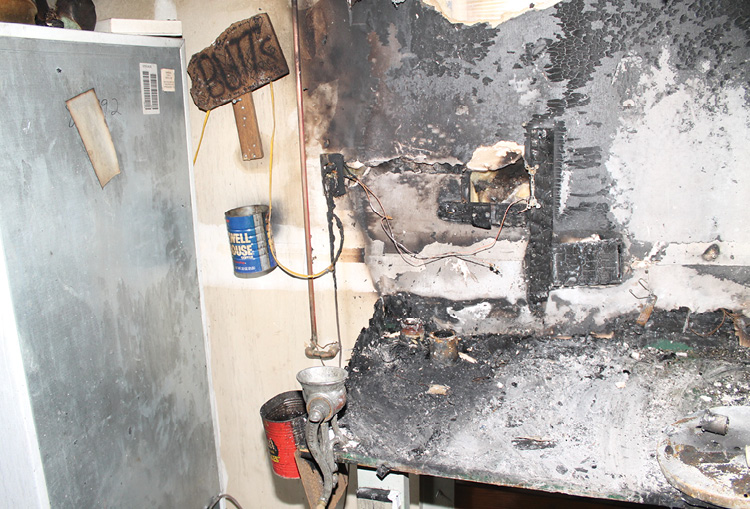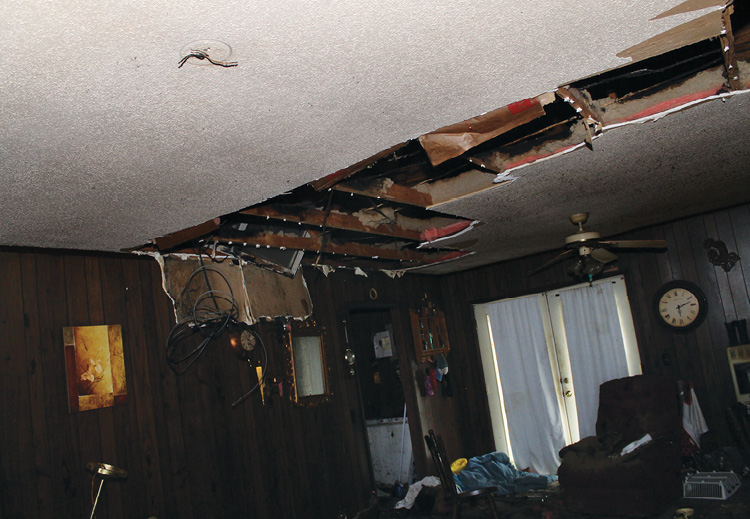
By Todd Soong
The decision-making process of today’s command official on the fire scene is extensive, complex, and often occurring under time-compressed circumstances. The critical decisions can have dire consequences.
However, as the fire scene mitigation transitions from the critical to the events of the “under-control” operation, you need to consider evidence preservation. Too often, practices and processes that go beyond reasonable overhaul come into play and can hinder investigative efforts. Overhaul can lead to spoliation if this line is crossed. Spoliation is defined as “loss, destruction, or material alteration of an object or document that is evidence or potential evidence in a legal proceeding by one who has the responsibility for its preservation.”1

(1) This magazine rack was found in the fire debris on the floor. By leaving the item in the room and the gypsum board on the wall, the scene can be reconstructed to prefire conditions. (Photos by author.)

(2) This gypsum board and pigtailed conductor was left in place. This allows the investigator to identify an arc fault on the affected conductor. The gypsum board shows the incorrect installation of the additional outlet.
RELATED
When does the overhaul of a fire scene cross this line? Are you cutting the bottom sash from a window opening to the floor to make overhaul easier? Are you washing the floor with a two-inch attack line? Are you leaving the scene and passing it on to the city’s public works department, bulldozer/excavator in tow, to push the building down?
Overhaul
When does complete overhaul become overzealous? At what point does overhaul become excessive? The mitigation of a fire scene necessitates overhaul, the process of final extinguishment after the main body of the fire has been knocked down. All traces of fire must be extinguished at this time.2
This decision, like many others in the fire service, will be based on many factors. For example, a fire crew equipped with the latest thermal imaging camera (TIC) and that has rapid response times and adequate fireground staffing will be able to leave the fire scene relatively intact following initial extinguishment. On the other hand, departments with fewer personnel, no TIC, and slow/prolonged response times may have to manage overhaul much differently: Delayering of the fire debris may have to be done manually and more intensely to ensure complete extinguishment.
Once complete extinguishment is verified, it is incumbent on that fire department to preserve fire scene evidence. Overhaul should not include as a matter of common practice the complete removal of all items within a fire room. Do not empty the room through a window or convert the window into a door to make it easy to remove large objects. If it is common practice or procedure for your department to remove all items within the fire room, change it.
These practices of excessive, over-zealous overhaul make it impossible for the fire service to fulfill its mandate to identify fire origin and cause. Only four factors determine an area of fire origin: fire pattern analysis, fire dynamics, arc fault mapping, and witness statements. Excessive overhaul can prevent the investigator from determining the origin of a fire within a structure or room. If all of the furniture is broken or thrown out and all wall and ceiling coverings (gypsum board, plaster) have been systematically removed, fire patterns cannot be analyzed. If the electric conductor system is destroyed (wires broken and scattered) during the removal of gypsum board with a pike pole, proper arc fault mapping cannot be conducted. These practices make it nearly impossible to indicate origin. When the area of origin cannot be established, it is difficult to assign cause.
Many times, the fire destroys the evidence left behind. The walls may be fully consumed or they may have collapsed and burned, destroying any patterns. Some furnishings may be nearly completely consumed by the fire, eliminating any pattern analysis they could have revealed. This is the nature of fire and fire investigation. However, when the evidence was left in place following fire suppression but was unnecessarily destroyed by excessive overhaul, the fire service is acting with negligence.

(3) By carefully removing only the gypsum board necessary to satisfy the amount of fire extension, conductors and ceiling coverings are preserved for the investigation. This also facilitates the use of the thermal imaging camera.
Consequences
What is at stake? The value of a solid fire scene investigation cannot be overlooked. This process may be the final voice for someone who has tragically perished in a house fire: the innocent victim of domestic violence, a child heinously burned alive by a malicious family member, or a fellow firefighter injured or killed as the result of a landlord code violation or the action of a murderer or an arsonist. What circumstances brought about their fate? What product fault or service delivery failure contributed to this fire? What fireground decisions impacted these events? Was an ignitable liquid poured? Was that window locked? Did a construction feature contribute to fire spread?
Often, the answers to these questions come from a systematic, scientific fire investigation. However, if a product failed and caused the fire but that same product was broken beyond recognition by overzealous overhaul, where will the justice be found? If gasoline was poured on a mattress and then ignited and that mattress was dragged out onto the driveway where the vehicles are parked, eliminating the ability to identify gasoline residue, that evidence is tainted. If a faulty process was used to wire the home and 95 other homes in the neighborhood are similarly wired but that wiring was violently pulled down and discarded, how will the future threat of that faulty wiring be identified and addressed? Aren’t we responsible for the safety of those 95 residents?
These and many other issues arise from the destruction of evidence at the fire scene. Looters, do-gooders, scrappers, and thieves can remove or move crucial fire scene evidence. A building ravaged by fire and left unsecured or unsecurable is susceptible to intrusion by these actors. However, it is inexcusable for the fire service to destroy the very evidence we are responsible for evaluating.
If Not Now, When?
Firefighters employ our skills at every fire—size-up, establishing command, two in/two out, accountability—and each is addressed at even the smallest fires. Why? We practice on the bread-and-butter, common fire occurrences and try to improve so we are prepared for the unusual, rarely occurring event that will need all of our focus, training, and ability. We do not have a well of super fire suppression powers waiting in one of the compartments on the truck we can pull out when there is a rescue or a Mayday. We have the tried-and-true fundamentals polished through constant training and use.
Fire investigation is no different. We will not be able to “save evidence” relative to the fire that claimed the life of a child or a fellow firefighter. If our overhaul principles are unsound on the “routine” fire calls, we are missing the point. From that perspective, we are keeping our fire investigation unit members from refining their skill set. If they are used to seeing a room devoid of fire evidence, gypsum board removed, broken wiring circuits, and so on, how will they respond to a room that is full of burned furnishings?
Fire investigation findings are often responsible for identifying many of the items that are recalled because they can lead to or cause fires. Sound investigations help us to understand the sequence of fire development and how to slow or halt it—information used for revising the building code. Origin and cause determination help us to understand the effects of ventilation, fuel packages, building construction features, and fire suppression activities.
Just like commanding a fire scene, starting an I.V., and quickly deploying a three-stage ladder, fire investigation skills are perishable and can become rusty. Investigators must constantly train and be well-prepared. However, if fire investigators see fire scenes only after the site has been excessively overhauled or the fire debris was thrown through a window, they will be denied the opportunity to develop those critical skills needed for investigating fire sites that have not been stripped of their furnishings. Their reports are critical to resolving major issues like murder, arson, a code violation, or defective merchandise or workmanship.
Be Excellent
As members of the fire service, we owe our very best to our neighbors. Our responsibilities range from protecting our communities and each other from the horrible effects of fire to teaching them how to prevent fires. The knowledge we gain from investigating and understanding the fire event is vital to the success of those goals. Let’s stop getting in the way of that mission:
- If you routinely throw everything out into the alley or yard, stop.
- If you have a TIC, standardize an operation that uses that technology during overhaul.
- If you must delayer the room of fire activity or of fire origin, be mindful of the task. Remember that the conductors in the wall and overhead will be analyzed for electrical activity and will be part of a “map.” If they are broken and scattered, the map will lead nowhere.
- Train to perfection. Be prepared. Be sharp.
Reference
1. National Fire Protection Association (NFPA) 921, Guide for Fire and Explosion Investigations, 2017 ed., 3.3.178.
2. NFPA 921, 2017 ed., 3.3.135.
Todd Soong is a retired fire officer from Rock Community (MO) Fire District and has served more than 25 years in the fire service. He is a fire investigator for NEFCO Fire Investigations. He is an instructor of the arson curriculum for the National Fire Academy and the International Association of Arson Investigators.

